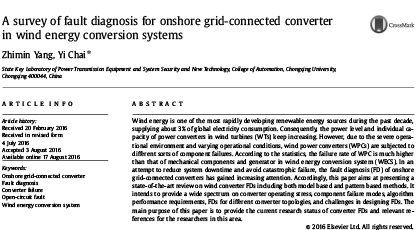The fault diagnosis of wind converter is in continuous development in recent years. It reduces the downtime and maintenance cost of WECS. and improves the system availability and operational safety. This paper has surveyed typical fault modes of the fragile components in wind converter and has provided a comprehensive review of the fault diagnosis methods used for numerous converter topologies. The issues of FDs performance and designing challenges have also been specifically discussed. As the power rating and density increasing. the failure and availability of wind converter become crucial. Numerous factors directly or indirectly cause the converter failures including severe operational environment. thermal cycling. EMI. etc.
The fault modes of fragile components are summarized on the analysis of the state-of-the-art work. Wind converter failures are diverse and mostly are short-circuit. open-circuit and ware-out fault of IGBTs. DC-Link capacitors and passive devices. The sensor faults are different from these components and mainly are offset fault. scaling fault. and measurement perturbation. Typical fault diagnosis methods along with algorithm performance requirements are presented according to the topologies of wind converter. The implementation effort. detection efficiency and algorithm robustness need to be considered in developing an appropriate FD. Both model based and pattern based fault diagnosis methods have been reviewed for diode rectifier based converter. 2L-BTB. 3L-NPC-BTB and MMC.
 Iran Energy News Oil, Gas, Petrochemical and Energy Field Specialized Channel
Iran Energy News Oil, Gas, Petrochemical and Energy Field Specialized Channel




